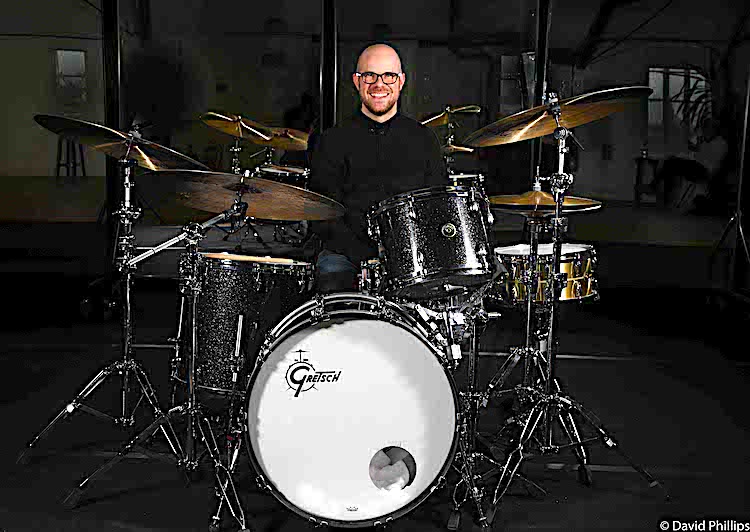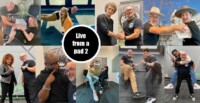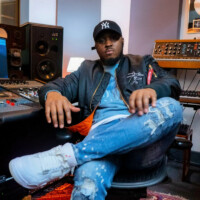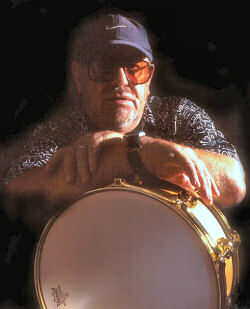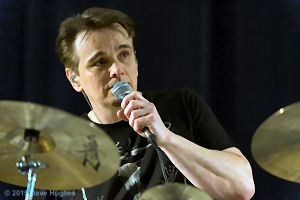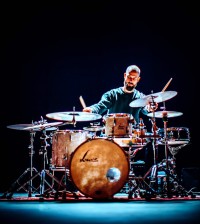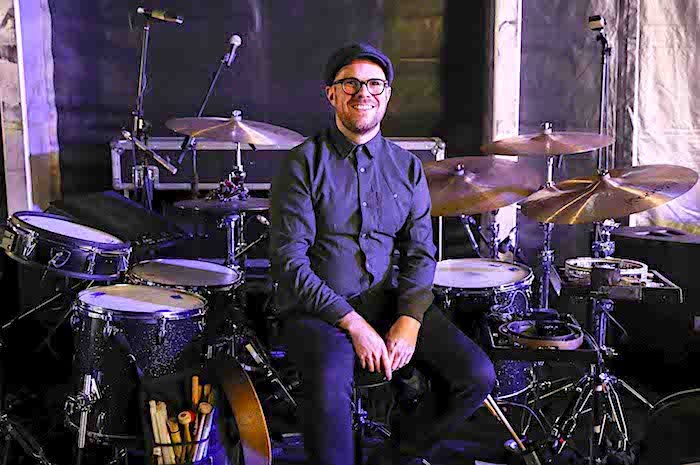 Born and bred in the small town of Prestwick in Scotland, John Blease discovered his passion for rhythm at a very early age – all thanks to a tambourine passed to him during choir rehearsal. Being hooked straight away, John went onto a journey exploring as much about drums as he possibly could which led him not only to discovering the musical roots of his motherland in various ceilidh bands but also saw him develop his passion for jazz.
Born and bred in the small town of Prestwick in Scotland, John Blease discovered his passion for rhythm at a very early age – all thanks to a tambourine passed to him during choir rehearsal. Being hooked straight away, John went onto a journey exploring as much about drums as he possibly could which led him not only to discovering the musical roots of his motherland in various ceilidh bands but also saw him develop his passion for jazz.
The urge to progress his drumming saw Blease soon look for input outside of Scotland and subsequently brought him to London. Since then he built an impressive career as a live and recording drummer working with a multitude of artists form all kinds of genres.
Paolo Nutini, Goldfrapp, Skepta, Goldie, The Heritage Orchestra, Jamie Cullum, Pete Tong and Tim Minchin are just a small excerpt of his CV.
This past year, John has not only been busy touring the world with UK soul legend Seal and gigging with Led Zeppelin front man Robert Plant but also found the time to record the soundtrack for a new documentary featuring the drums at the centre of its soundtrack.
I caught up with John to chat about his upbringing in Scotland, his background in jazz, his path to playing new genres and his work on Paolo Nutini’s new album.
Why drums?
I didn’t have anything to do with drums until the end of primary school. There was a choir in which I was singing and one day the teacher asked who wanted to play the tambourine. She handed it to me, we started playing a song and I can still remember what that felt like to this day. It was amazing!
That was at the end of the school year so I had the whole summer off and started watching Top Of The Pops a lot. I constructed a little drum kit out of Lego boxes in my bedroom and just copied what the guys on the television did. I got some basics together and as soon as I got to the big school I was asking for drum kit lessons. From that moment with the tambourine I knew I was gonna be a drummer.
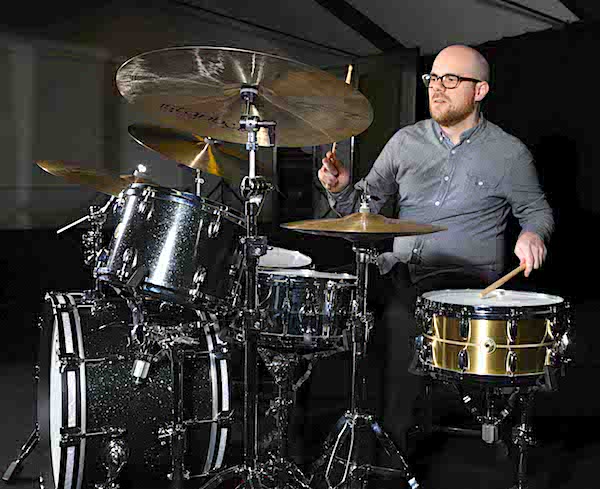 Career decision made. Where did it go from there?
Career decision made. Where did it go from there?
From the moment they agreed to give me drum kit lessons to this day, I have been obsessed with drums. It’s my life. I studied with the school’s drum teacher Mr. King and was very lucky to have a music teacher, Mr Wilson, who put in loads more hours to offer a big band, a wind band and even opportunities to do your own stuff. His taste in music was more towards jazz so he introduced me to Pat Metheny and the Yellow Jackets. That gave me a real buzz and I really got into it. After a while my teacher at school didn’t quite know what to teach me anymore so my mum started to take me down to London to a place called Drumtech. I went for a lesson with Brian Greene there but I was just too young, so he pointed me in the direction of a guy called Dave Hassell in Manchester. So when I was about 15/16 my mum every couple of months used to take me down to see him for a two hour lesson. That was enough to blow my mind for a couple of months. It is really due to Dave why I’m still here playing drums today. He taught me a great deal.
After school I applied for music colleges and went to study jazz at Royal Academy in London for four years.
As a teenager I was out doing pub gigs playing with a lot of older jazz, fusion and rock musicians; I’m very thankful to my dad for driving me around to all of that. I also played at dances with ceilidh bands every Friday and Saturday so I was earning quite good money for a 14/15 year-old.
How has growing up in Scotland influenced your musical upbringing?
Well, Scotland is very different to anywhere in the world really. Firstly I feel very proud to come from there. Musically it’s unique because of all the folk music. We’ve got our own dances, our own kilts, our own drinks – so growing up it’s all just part of the culture. The music is in the air. Being a musician there I’ve played in ceilidh bands my whole life. I also played in the Ayrshire Fiddle Orchestra which was about 60 violinists, a few accordion players and a couple of guys on snare drums playing Scottish music. There was a guy a couple of years older than me, Gavin, who showed me a lot of things on the snare drum. So music was around all the time and still now I play a bit of folk music. I love it and it’s just in me, you know.
I’m really interested in guys nowadays who are pushing the possibilities of folk music. It’s really hard to do that and especially hard to be a drummer in it because you don’t actually need one. A lot of times in bands you need a drummer to make people feel like they want to move but folk musicians are so used to playing without a drummer, their time is incredible. People just move to that. You could have a dance with one guy with a whistle. I find that amazing and I’ve learnt a lot from playing with musicians from that background.
Studying at the Royal Academy is what brought you to London then?
Yes. That was the only reason I moved to London. Obviously, as you know, London is a melting pot for music and probably one of the best places to be in the world if you have an interest in music. I was drawn to that. Not just for me, my playing and the studying, but also the fact that all the greats are coming through here. I used to watch Elvin Jones all the time at Ronnie Scotts. You can go anywhere and catch live music any night of the week and meet like minded people. That was very attractive to me coming from a small place in Scotland.
Was it the Royal Academy that has given you somewhat of a jazz background or has that always been a passion?
I got into jazz when I was about 15. I joined the National Youth Jazz Orchestra of Scotland. They introduced me to lots of different kinds of jazz and it just connected with me. I met a few people my age and we used to get together every Sunday to have a jam session. Everyone would make tapes for the others to listen to and we’d spend ages each week talking about them. That’s how I learned music back then. Just by sharing and copying tapes for each other. We were a 5-piece and actually did pretty well in Scotland. That’s when I really got into jazz heavily.
When I went to the Academy it was predominantly a jazz course although there were a lot of other things going on too. The advice from my teacher, Paul Clarvis, was to soak it all up even if you don’t feel it connects with you entirely. You need to be very versatile in order to make a living, so you’ll never know when it’s gonna be useful. We had studio classes on how to play in a studio, how to create arrangements really quickly, writing charts and things like that; as well as doing completely free improvised, more conceptual and philosophical things. I just soaked it all up.
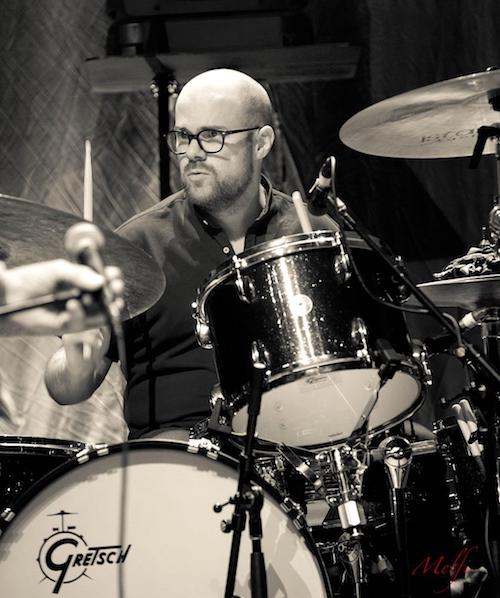 There was quite a bit of percussion involved in the course too, right?
There was quite a bit of percussion involved in the course too, right?
Well it’s mainly a classical music place so the jazz course is very small. In my year there was only eight of us, so they basically accept a band. Because I got the advice on being well-rounded I had studied a little bit of orchestral percussion in Scotland with a lady called Pam Dow. I wanted to continue that so I had what they called ‘second study’ classical percussion lessons where I learned orchestral excerpts on the snare drum and tuned percussion. I do a little bit of that these days but there is a total limit on my ability. There are people out there who can do this much better than me. It’s a different world.
So we’re talking about a Scottish kid with a passion for jazz drums and a brief background in classical percussion, who then got into drum’n’bass, electronics and hybrid drums. How did that happen?
I haven’t done that much electronic stuff this year but the 5/6 years before that I did quite a lot of stuff involving electronics. It’s all to do with who you’re playing with and what the music asks of you. The whole electronics side of things started for me in a bigger way when I got the gig with Ghostpoet. He is a great musician and vocalist who’s got four records out now. Back then I joined him to tour his second album and then recorded his third record which we then toured as well. That second album was very electronic and even only had 2 tracks with acoustic drums on it.
A good friend of mine John Calvert was in his band at the time. John is an incredible musician and producer and I had known him and his brother Matt since I moved to London. They have both been involved in Ableton since day one, and I was always hanging out with them and we made a lot of music together. We would just experiment with Ableton and do all these things that are quite common now that the technology has got better. With Ghostpoet I was able to bring that into the kit and have triggers, an SPDSX, expression pedals as filters, delays and just exploring how that all could be more musical. We were really cooking with gas back then but recently the things I’m doing aren’t so heavy on the electronics so it has taken a bit of a backseat on me.
Most of the stuff I’ve done last year were just about playing the kit and it was actually quite refreshing to come back to that. However, I would say that having an understanding of electronics, in some form, is absolutely essential in todays world as a drummer.
This past year you where mainly touring with Seal. That was a mixture of Pop and Big Band, right?
It was exactly that. On paper it was Big Band for half, hits for half. Somehow through the musicians involved it did have a thread though, so it did work as a show. It’s a bit of a cliche to say but if you have a broad background you can make the music your own and that’s what we did. We started in January and went on to tour the UK, Europe and Australia. They also went to tour America but I had to dep that out to a US drummer because I took on another gig. The tour has finished now and Seal is back in the studio to work on a new record.
It was a really fun time and there were some great musicians on it. We had Graham Godfrey on percussion which was helpful because all this 90s music has layers and layers of percussion and I had no idea how to cover it all. I figured they would put it all on track, which I’m not fond of really, but the only thing on there was Seal’s backing vocals. He’s quite specific about them because they’re such a big part of the sound of the songs.
I was playing along to these tunes as a teenager you know. It was crazy to now play them with Seal himself.
Talking about playing with your teenage heroes, you played with Robert Plant this year as well.
Yes. It’s quite something and I’m very much enjoying that, of course!!!
He’s obviously known for being the singer of Led Zeppelin so I guess people who don’t know his whole career would assume that he’s only a rock singer, even though Zeppelin was a great deal more than that! We do actually play a lot of Zep tunes but while we do play a few songs exactly like Zeppelin, the majority become very different in terms of feel, sound and arrangement. I guess any person doesn’t want to do the same all the time and Robert especially wants things to evolve constantly.
In this band, I really get to explore every side of my drumming and musical experience. I get to do the electronic stuff, there are a lot of loops on four or five tracks with quite complex triggering, then I play really loud rock drums, North-African rhythms, the next number is really jazzy and so on. The dynamic range really is form pin-drop to face-melting and I get to play behind one of the greatest and most bad-ass singers that ever lived with 50 years of material and a kick-ass band. It’s pretty much my ideal gig and I feel very fortunate. I’m learning a huge amount by doing it as well because I get exposed to a lot of music that I’ve heard before but never really absorbed fully, particularly blues material. It’s great!
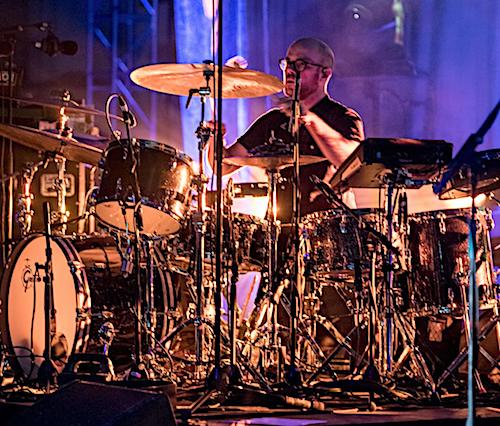 Another gig you’ve done for quite a while now is Goldie. It’s a double-drummer set up that you’re sharing with Adam Betts?
Another gig you’ve done for quite a while now is Goldie. It’s a double-drummer set up that you’re sharing with Adam Betts?
Yes. It’s two drums because it has to be. Adam and myself have known each other for years. We studied at the Royal Academy together.
The gig came about through the Heritage Orchestra that we’ve both played in for years. The orchestra has been going for 14 years and I’ve been doing it from the beginning. We were just a bunch of friends who put together a gig at this club called Cargo in East London. We used to schlepp all the gear in ourselves, organised everything, no money.. ah, it was a nightmare. It then started to grow a little bit and did an album too. Back then we actually wrote our own music but it then became more a backup orchestra for artists.
Through that we’ve played with Ben Folds, Massive Attack, Giorgio Moroder, Scott Walker, Airto Moreira, The Streets, Anthony & The Johnsons, Tim Minchin and lots, lots more. I got to meet a lot of people by playing great music. That’s really where I play my orchestral stuff. One of the projects we did maybe five years ago was playing the album Timeless with Goldie for the anniversary of its release date. We did that with the full orchestra at the Royal Festival Hall and it went so well that we did another three nights the next year. Goldie really liked me and Adam and asked us to come in to do some drum recordings with him. That was all on his album “The Journey Man” and we went out with him to tour it. Now we’re this little band he uses. We’re doing lots of festivals, went to Thailand – it’s a great gig!
I didn’t really know much about this type of music beforehand but now I’m getting educated by one of the main figures of the genre. I was actually a little worried that I wouldn’t have anything in common with Goldie but when we had our first phone call we hit it off straight away. He knows loads about jazz, Pat Metheny, B-sides and live albums which I wasn’t expecting at all. We get on really well and it’s actually great to play music with people who can’t play an instrument but still know exactly what they want in their head. If you can bring that out, that’s really exciting. Goldie was actually making drawings for us (because he’s an artist as well), so we were playing paintings. It sounds weird but it worked and I learned a lot from him. The energy at the gigs is amazing too if you have this guy with gold teeth in your face making you really play 110%.
You’ve also done a lot of recording this year.
Yes. I’ve been lucky, I had a very busy year.
I have my own studio in London where I keep all my drums and have a little booth with a kit all mic’d up. I do quite a lot of sessions from here. I’m actually gonna record some tambourine later for this guy from Australia who I’ve recorded an album with at Abbey Road earlier this year. It’s great that I can record 10 minutes from my house for people all around the world and have actually played on some decent songs from here. I did a track for Corinne Bailey Rae for example. I’ve also recorded a lot of library music from here over the years.
However, this year I have mainly been recording in larger studios. The main thing was probably working on Paolo Nutini’s new album whom I’ve played with live off and on. I love that because it brings the Scottish thing back. He’s Scottish, a lot of guys in the band and crew are Scottish – it’s just fun to be on the road with a bunch of Scots.
We’ve been recording for the album on and off for the past 3 months. Whenever we find time really. We did a week at Rockfield in Wales and then in August we went to ICP studios in Brussels for three weeks. That’s an incredible place. They have three or four studios there, you live there and they have storage full of equipment: every guitar amp you could wish for, loads of synths, 16 drum kits, 50-60 snares, a huge load of cymbals and all the percussion you could ever need. I could just go in there and pick up whatever I wanted, which is amazing when you’re working on a track. I had a Ludwig Vistalite set up in one room, more close sounding; and in a second room I put together a little kit using all these old no-name drums they had lying around. The studio laughed at me for choosing that instead of one of all these high-end kits they have but it was just the sound I like and that was needed. I’m hoping that that record turns out good.
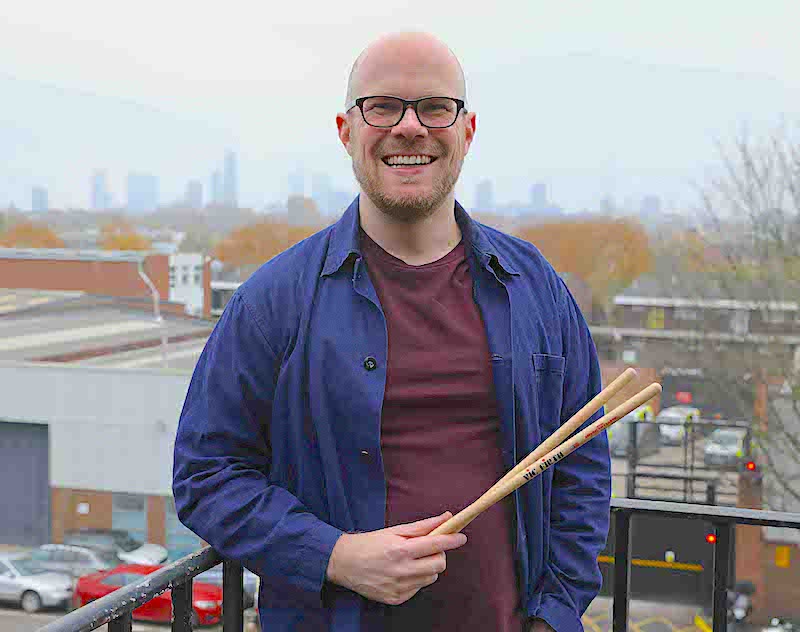 Are you quite a gearhead anyway?
Are you quite a gearhead anyway?
Yeah, I guess I am. I can’t deny it. I don’t really realise it though because the people I look up to and listen to are all like that, so I don’t see anything different. It’s only when someone comes round to my studio and their jaw drops. I’m not as bad as some people but I’m getting there. Mainly because I now endorse Gretsch drums and have amassed eight snare drums from them as well as a kit. I already had 12 plus other snares and several kits. It’s getting a bit out of hand! I’ve also bought and been given a lot of cymbals lately from Istanbul Agop, I love them, so when all my gear gets back to the studio at the start of November I’ll have to have a little look at things!
The reason I have all these instruments though is because I use it all. Even the orchestral bass drum and all the weird cowbells I have. Last Monday I used a drum kit with a 16” bass drum, a 10” snare, Djembe with a splash on it, little concert toms… all these weird sound effects. If you can figure out a way to use it in a musical way rather than just being a sound, then it’s worth while.
The point is: when people come here to my studio, I’ve got everything. When I go to a studio I’m always limited by how much stuff I can fit in my car. I always ask what sound they’re looking for to try and take the right things but it’s never as easy as being here with all my stuff. You make do though. Actually this year I have started to not take anything if the studio has a house kit. I quite like the challenge of making that work now.
You’ve recently been involved in the soundtrack for a documentary too?
Yes, that was with a composer called Max De Wardener who does a lot of library music and soundtracks whom I had recorded drums for before. He got in touch about this Channel 4 documentary about climate change. He had actually taken a bunch of drum tracks from a previous session I had done and looped them up to make a demo for the documentary which he pitched to them as an idea with the drums as a focus. Maybe a bit like the ‘Birdman’ movie. They really liked the idea so I went back into the studio to re-do all the drums more specifically to the picture. I really enjoy doing things like this. I didn’t think much of it when I recorded it here but I got invited to the screening in Soho and it was awesome! The visuals, the story and the way it sounds is magic. Its called “Saving Planet Earth:Fixing A Hole.”
Finally, what’s next?
Well, a record I have played on with my good friend Matt Calvert has just come out, called Typewritten. We’ll be looking at doing some more shows in 2019 hopefully, I am so proud of this music and think it is one of the best things I have done.
It’s looking like I will be on the road with Alfie Boe start of next year and then hopefully have dates with Robert and Paolo after that, fingers crossed!
Also, I want to continue to develop my studio and keep working on things from there. Its a non-stop journey and I love it!
Thanks a lot for your time John!
Interview by Tobias Miorin
December 2018


